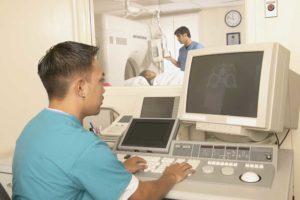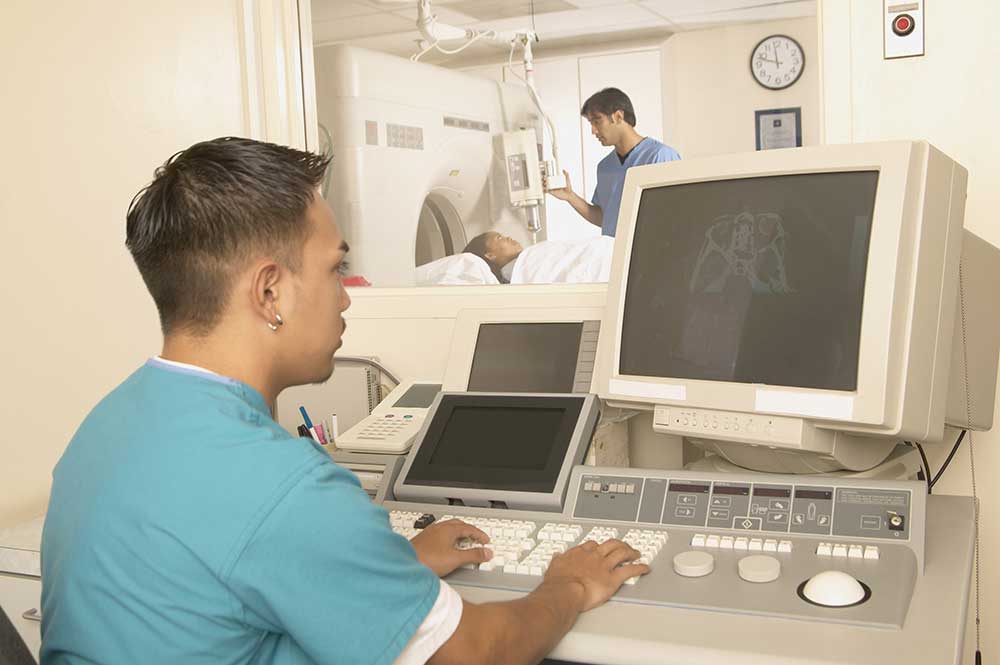Disclaimer: The information on our website is provided for general information purposes only. We make no representations or warranties of any kind, express or implied, about the completeness, accuracy, reliability, suitability or availability with respect to the website or the information contained on our website for any purpose. Any reliance on such information is therefore strictly at your own risk and we are not liable for any damages or losses arising out of or resulting from your reliance on any information contained on our website.
A radiologic technologist and technicians take diagnostic imaging exams on patients using computed tomography imaging (CT Scans), X-rays, and other technology such as mammographs. With on-the-job experience and a 1-2 year certification program, radiologic technologists can also become MRI technologists.
Watch a video to learn about what a radiologic technologist does:
How to Become a Radiologic Technologist

A radiologic technologist or technician can earn either an associate or a bachelor’s degree in radiologic technology. However, an associate’s degree is usually the traditional track along with a license or certification depending on the state one resides in and their requirements. The primary difference between a technician and a technologist is their level of education.
Many technologists earn bachelor’s degrees where a technician usually has a lower level of training, such as a certificate or 2-year degree. In addition, you commonly see technologists with more responsibility such as supervisory duties. Both degree tracks usually provide clinical and classroom training that focuses on courses in pathology, anatomy, imaging evaluation, physics, equipment, and safety procedures. Some radiologist technologist advance into MRI technologist after gaining on-the-job experience.
Certification may or may not be required depending on state law but many employers ask for certification regardless and being certified can certainly help give you a competitive edge. You can get your certification through the American Registry of Radiologic Technologists (ARRT) if you meet their educational and ethics requirements and pass a certification exam. You will need to have at least an associate degree in radiography from an accredited educational program and not have any felony or misdemeanor convictions to obtain this certification. A radiologic tech can also become an MRI technician after they receive on-the-job training and attend an accredited MRI technology certificate program.
Job Description of Radiologic Technologist
A radiologic technologist and technician both specialize in performing computed tomography imaging (CT Scan) and X-rays for patients that have been referred. They may mix a required drink that allows the soft tissue to be seen on the image that is examined. They provide mammography exams through low-dose X-ray imaging. They gather the medical history of patients and keep detailed records of any procedure given. Radiologic technicians also address any questions or concerns that patients may have about the testing.
Testing a patient involves following directions from the physician on a particular area of the body and protecting other exposed areas that are not being scanned. Positioning the patient for exams is important for obtaining the correct images and then reviewing the pictures with the physician to determine if further scanning or X-rays need to be done. He or she is responsible for maintaining the equipment and making any necessary adjustments.
Radiologic technologists and technicians work long hours standing on their feet and often are required to lift and turn of patients. This occupation carries the risk of exposure to infectious diseases, however, when following proper procedures it reduces these risk factors. Most radiologic technologists can be found working in medical or surgical hospitals, physician’s offices, or in laboratories.
Recently there has been an influx of work in outpatient care centers to help reduce the cost for patients, it is otherwise known as a very expensive procedure. The Bureau of Labor Statistics projects growth in this career field due to the older population living longer and the availability of better health care insurance.
Continued Career Research
You can also learn more about this career field directly from the ASRT website (American Society of Radiologic Technologist). You can also check out scholarship opportunities available for those entering a radiologic technology program directly from the ASRT Foundation.
Radiologic Technologist and Technician Video
Looking inside the human body without resorting to highly invasive surgery is the work of Radiologic Technologists and Technicians. They perform X-rays, CAT scans and other imaging examinations, to help doctors develop accurate diagnoses. The technician positions the patient to get the clearest possible image results, before activating their equipment.
Helping patients feel calm and explaining the procedure is part of the job. For certain procedures, they administer non-radioactive materials into a patient’s bloodstream. Technicians also monitor the video display of the area being scanned, adjusting controls to improve picture quality. Technologists may also perform imaging examinations, but in addition, they have the skills to evaluate the quality of the image.
They are responsible for handling infectious and radioactive materials and ensuring that safety measures meet government regulations. They may oversee radiologic staff, assigning duties and supervising the work, and help the facility’s administration develop operating budgets and make new equipment purchases. Radiologic technologists and technicians work in hospitals, doctor’s offices, or clinics and laboratories.
Typically, an associate’s degree in the field is required, and in most states, they must also earn a license or professional certification to practice. A certification can strengthen employment prospects significantly, even if the state does not require it. Produced by CareerOneStop. CareerOneStop is sponsored by the U.S. Department of Labor, Employment and Training Administration.
Article Citations
Bureau of Labor Statistics, U.S. Department of Labor, Occupational Outlook Handbook, Radiologic Technologists.
National Center for O*NET Development. 29-2034.00. O*NET OnLine.

